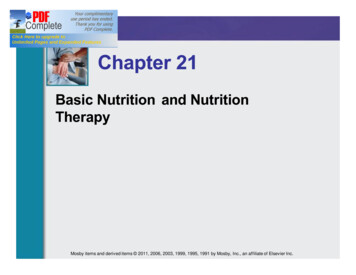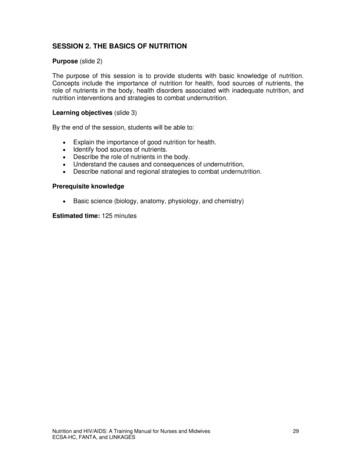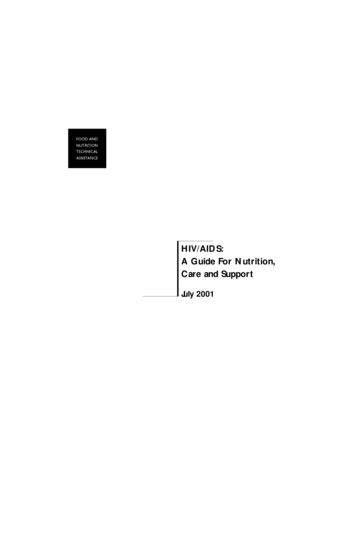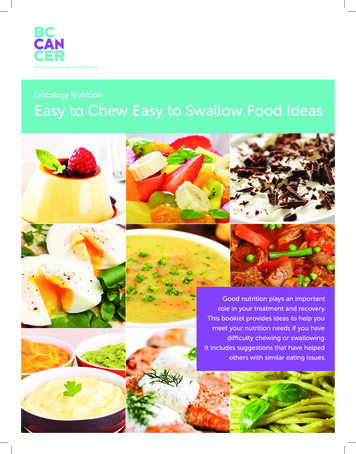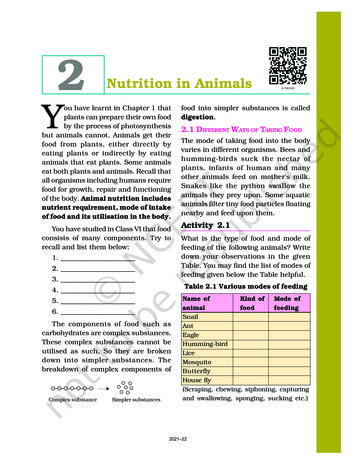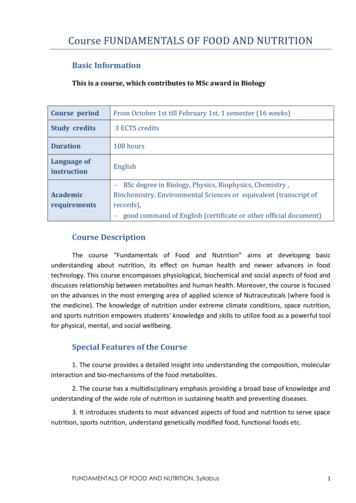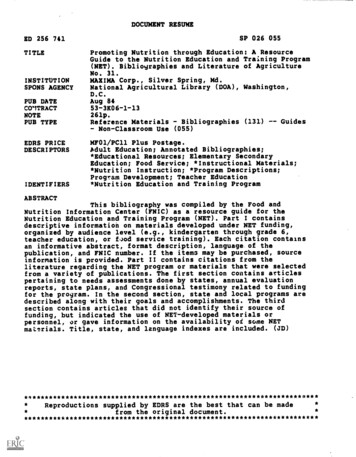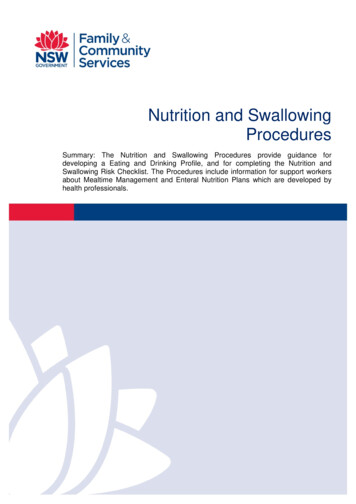
Transcription
Nutrition and SwallowingProceduresSummary: The Nutrition and Swallowing Procedures provide guidance fordeveloping a Eating and Drinking Profile, and for completing the Nutrition andSwallowing Risk Checklist. The Procedures include information for support workersabout Mealtime Management and Enteral Nutrition Plans which are developed byhealth professionals.
Nutrition and Swallowing ProceduresDocument nameNutrition and Swallowing ProceduresPolicyHealth and Wellbeing PolicyVersion number1.3Approval dateJanuary 2016Policy manualHealth and Wellbeing Policy and Practice Manual,Volume 1Approved byDeputy Secretary, ADHCSummaryThe Nutrition and Swallowing Procedures provideguidance for developing an Eating and DrinkingProfile, and for completing the Nutrition andSwallowing Risk Checklist. The Procedures includeinformation for support workers about MealtimeManagement and Enteral Nutrition Plans which aredeveloped by health professionals.Replaces documentNutrition and Swallowing Policy Dec 2010Authoring unitContemporary Residential Options DirectorateApplies toPeople who are being supported in ADHC operatedaccommodation support services.Review date2017
Version controlThe first and final version of a document is version 1.0.The subsequent final version of the first revision of a document becomes version1.1.Each subsequent revision of the final document increases by 0.1, for exampleversion 1.2, version 1.3 etc.Revision historyVersionAmendment dateAmendment notesV1.0November 2014Replaces the 2010 Nutrition and SwallowingPolicy and the Eating and Drinking PlanV1.1January 2015Amended to incorporate feedback from dietitiansV1.2January 2016Amended to incorporate feedback from FACSDistrictsV1.3June 2016Amended to incorporate feedback from FACSDistrictsNutrition and Swallowing Procedures, V1.3, June 20162
Table of contents123Nutrition and Swallowing Procedures. 51.1 Introduction . 51.2 Procedures, guidelines, tools and templates . 51.3 Who do the Procedures apply to? . 6Nutrition and Swallowing Risk Checklist . 82.1 Who completes the Risk Checklist? . 82.2 How to complete the Risk Checklist . 92.3 Completing Part 1 - Preliminary Profile . 92.4 Completing Part 2 – Nutrition and Swallowing Risk Checklist . 132.5 Completing Part 3 – Summary of Results. 262.6 What to do with the completed Risk Checklist . 262.7 ADHC therapist referral process . 282.8 When all responses are ‘No’ . 302.9 Risk Checklist verification . 302.10 Review of the Risk Checklist . 30My Eating and Drinking Profile . 313.1 Who should have a My Eating and Drinking Profile? . 313.2 Completing the My Eating and Drinking Profile . 323.3 The person’s details . 323.4 Allergies and medication . 333.5 Eating and drinking preferences . 333.6 Religious and cultural food /drink preferences . 343.7 Eating and drinking equipment . 343.8 How to assist the person to eat . 353.9 Providing supervision at mealtimes . 353.10 Time . 363.11 Atmosphere . 363.12 Communication style and behaviour . 373.13 Participation in food related activities . 383.14 Eating out . 393.15 Support items for eating out. 393.16 Communicating while eating out . 403.17 Ordering a meal when eating out. 403.18 Favourite meals when eating out . 413.19 Venue . 413.20 Transport . 413.21 How to use the person’s My Eating and Drinking Profile . 423.22 Review of My Eating and Drinking Profile . 43Nutrition and Swallowing Procedures, V1.3, June 20163
4563.23 Update the person’s risk and safety information . 433.24 Refer to Nutrition and Swallowing Guidelines . 43Mealtime Management Plan and Enteral Nutrition Plan Procedures434.1 What is mealtime management? . 434.2 What is enteral nutrition? . 444.3 Support plan templates . 454.4 Responsibility . 464.5 Review of mealtime management plans . 504.6 Mealtime support outside of the accommodation support setting . 504.7 Support plan sign off. 524.8 Distribution of Mealtime Management Plan and Enteral Nutrition Plan. 52Glossary. 53Policy and Practice Unit contact details . 55Nutrition and Swallowing Procedures, V1.3, June 20164
1 Nutrition and Swallowing Procedures1.1 IntroductionThe ADHC Nutrition and Swallowing Procedures (the Procedures) embody theprinciples of legal and human rights found in the New South Wales DisabilityService Standards (the Standards), the commitment to deliver culturallyresponsive services to Aboriginal people under the Aboriginal Policy Statement(the Statement), and the person centred guiding principles of the ADHC Healthand Wellbeing Policy.The Procedures are a guide for supporting people with disability to exercise theirrights and entitlements under the Standards and the Statement.The Procedures describe how ADHC supports people to record their preferencesin relation to nutrition, capture risk related to nutrition and swallowing and how tofollow a Mealtime Management Plan or Enteral Nutrition Plan. The Procedurescontain alerts to risks associated with swallowing difficulties and how these aremanaged under the guidance of the person’s ‘usual’ general practitioner (GP)1 andother health specialists.Nutritional health is a basic human right for all people. Eating nutritious food isimportant for maintaining good health. Food keeps us functioning, alert and activeso that we can fully participate in family and community life. Poor nutrition hassevere, adverse consequences for a person’s health.People with disability are often dependent on others for access to nourishing,enjoyable and culturally appropriate food which meets the Australian DietaryGuidelines2, and is provided in a form that is safe for them to eat and drink.People with disability living in supported accommodation must be supported toachieve and maintain nutritional health, and experience its benefits. Thesebenefits are a sense of wellbeing, improved physical health, less likelihood ofillness, capacity to participate more in home, family and community life andprevention from harm.1.2 Procedures, guidelines, tools and templatesThe Procedures provide support workers with instructions for the development,implementation and review of the following: Nutrition and Swallowing Risk Checklist – a tool to screen people fordifficulties related to nutrition and swallowing.1Medicare defines the person’s ‘usual’ GP as: ‘The GP (or a GP in the same practice) who has provided the majority ofservices to the patient in the past 12 months, and/or is likely to provide the majority of services in the following 12 n and Swallowing Procedures, V1.3, June 20165
My Eating and Drinking Profile – captures the person’s mealtimepreferences at home and in the community Mealtime Management and Enteral Nutrition Plans – prescribed by theperson’s GP or appropriate allied health professional (AHP) e.g. accreditedpractising dietitian (APD).Support workers are responsible for completing actions contained in theProcedures, including reviews, and for implementing recommendations made bythe person’s GP or AHP within prescribed timeframes.Refer to the Nutrition and Swallowing Guidelines for guidance and referencematerial for supporting a person to eat a healthy balanced diet and live a safe andhealthy lifestyle.Refer to the Nutrition and Swallowing tools and templates for copies of blanktemplates.1.3 Who do the Procedures apply to?The Procedures apply to ADHC operated and funded non-governmentaccommodation support services.Nutrition and Swallowing Procedures, V1.3, June 20166
Flowchart 1: The nutrition and swallowing annual cycle that support workers mustfollow to ensure the person eats and drinks safely and nutritiouslyNutrition and SwallowingAnnual CyclePrepare for annual healthassessmentComplete Nutritionand Swallowing RiskChecklistChecklist answeredwith Yes or Unsure /Don’t knowresponses?Develop the Eatingand Drinking ProfileNoYesProvide support using:§§§§§My Eating and Drinking ProfileEasy Step by Step CookbookNutrition and Swallowing GuidelinesHealth Promotion GuidelinesChronic Disease GuidelinesRepeat the Nutrition andSwallowing Risk Checklist in12 months or immediatelywhen the person appears tohave difficulty eating ordrinking, or their skills andabilities change.Support the personto see their GPwithin 7 daysGP prescribessupportGP refersperson to AHPSupport the person asprescribedAHP prescribesMealtime ManagementPlan (MMP) or EnteralNutrition Plan (ENP)Support the personexactly as prescribed inMMP or ENPCycle repeats in 12monthsPrepare for annual healthassessmentComplete Nutritionand Swallowing RiskChecklistNutrition and Swallowing Procedures, V1.3, June 20167
2 Nutrition and Swallowing Risk ChecklistThe Nutrition and Swallowing Risk Checklist (the Risk Checklist) is a way ofscreening people for difficulties related to nutrition and swallowing. Ideally the RiskChecklist is completed as part of the person’s annual health planning process.The Risk Checklist cannot make a diagnosis of a medical condition. A diagnosiscan only be made by the person’s GP or an allied health professional (AHP) theGP has referred the person to for advice.It is mandatory to complete the Risk Checklist for people who reside in ADHCoperated and funded non-government accommodation support services andaccess centre based respite services.It is mandatory for the Risk Checklist to be completed annually as part of aperson’s annual health planning process (refer to Health Planning Procedures), orsooner if the person’s usual way of eating or drinking, health, behaviour or skillschange.The Risk Checklist template is located in the Health and Wellbeing Policy andPractice Manual, Volume 1, Nutrition and Swallowing, ‘Tools and templates’section.Guidance for completing each question in the Risk Checklist is provided in theseProcedures.2.1 Who completes the Risk Checklist?2.1.1 People residing in accommodation support servicesAll questions in the Risk Checklist must be completed by a support worker whoknows the person well and with the assistance of the person as much as possible.If the person consents, collaboration with a family member and/or others whoknow the person well may be helpful in obtaining the most accurate result.If this is not possible, it is preferable to have another support worker who knowsthe person well or the line manager, e.g. Team Leader, assist with completion ofthe Risk Checklist.2.1.2 People accessing centre based respite servicesPeople accessing centre based respite services should be supported to completethe Risk Checklist with their family or carer, Case Worker or Respite Client LiaisonOfficer (RCLO).The provision of respite is contingent on completion of the Risk Checklist andmanagement of identified risks by the person’s GP or AHP. Refer to Centre Based Respite Procedures for more information.Nutrition and Swallowing Procedures, V1.3, June 20168
2.2 How to complete the Risk ChecklistIdeally the Risk Checklist is completed within the seven days prior to the person’sannual health assessment with their GP.The Risk Checklist has three parts:Part 1 – The Preliminary ProfileThe Preliminary Profile records information about the person’s weight and height,BMI and who is completing the checklist.Part 2 – Nutrition and Swallowing Risk ChecklistThe Risk Checklist assesses if the person has signs of nutritional problems orswallowing difficulties that may affect their health.Part 3 – Summary of ResultsThe Summary of Results table records descriptions of the risks or issues ofconcerns relating to questions answered with a ‘Yes’ or ‘Unsure / Do not know’.The GP should review the Summary of Results and prescribe action to be taken inthe shaded ‘Further Action Required’ column.2.3 Completing Part 1 - Preliminary ProfileComplete the person’s details and accurately measure their weight and height byfollowing the guidelines below.2.3.1 Accurately measuring weight:1. Weigh the person in the same clothes if possible. Lightweight clothing is best.Ensure they take their shoes off. Remove any helmets, mobility supports etc.2. Weigh the person at the same time of day e.g. mornings prior to breakfast.3. Allow the person to use the toilet to empty bladder and bowels before beingweighed.4. Weigh the person using scales situated on a flat, level hard surface.5. Ensure the scales are of good quality and are in good working order.2.3.2 Measuring the weight of a person who is unable to maintain theirbalance or requires mobility aids to stand.Use chair scales to accurately measure the weight of a person who has difficultymaintaining balance or standing without mobility aids.Support the person as per points 1-5 above in 2.3.1.Ask the person to sit in the chair scales with their feet on the foot rests and recordtheir weight.Nutrition and Swallowing Procedures, V1.3, June 20169
2.3.3 Measuring the weight of a person in a wheelchairA person in a wheelchair or who is unable to stand without support can beweighed using wheelchair scales. These scales are available in some grouphomes and large medical centres including hospitals and health services.1. Weigh the empty wheelchair and record the weight.2. Support the person to dress in light clothing and sit in the wheelchair.3. Ensure the tray table is either removed or remains in place each time toensure consistency.4. Move the wheelchair onto the scales and engage the brake.5. Record the total weight and deduct the weight of the wheelchair to obtain theperson’s correct weight.2.3.4 Accurately measuring a person’s standing height (stature)measurementEquipment required: Stadiometer or steel ruler or tape measure placed against asolid wall.Procedure: Standing height is the measurement of the maximum distance fromthe floor to the highest point of the head when the person is facing directly ahead.For accuracy: Shoes must be removed. Remove any head wear or hair accessories. Feet to remain together as closely as possible. Arms to hang loosely by sides of body. Heels, buttocks and upper back should be in contact with the wall as closelyas possible.NOTE: Height can vary throughout the day. A person is usually taller in themorning. To ensure reliability, measure the person’s height at the same time ofday.2.3.5 Accurately measuring the height of a person who is unable to stand using half arm-spanThis method of measuring height can be used on a person who is unable to stand.Half arm span (also known as demi span) is the distance from the midline at thesternal notch to the tip of the middle finger.Equipment: Tape measure, pen and paper.Nutrition and Swallowing Procedures, V1.3, June 201610
Procedure:1. Locate the edge of the right collar bone and note the sternal notch (seediagram below).2. Support the person to place their non-dominant arm in a horizontal positione.g. if they are usually right handed, use their left arm.3. Ensure the person’s arm is horizontal and in line with the shoulders.4. Ensure the arm is flat and the wrist is straight.5. Using the tape measure, measure the distance between the sternal notch tothe tip of the middle finger.6. Take the reading in centimetres and record.7. Calculate the person’s height using the formula below.For females: height in cm (1.35 x half arm span (cm)) 57.8For males: height in cm (1.40 x half arm span (cm)) 57.8Example: the person is female and her half arm span is 70cm.Her height would be calculated as follows:(1.35 x 70 94.50) 57.8 152.3The person’s height is 152.3 cm2.3.6 ChildrenGrowth rates for children and young people aged less than 18 years should beassessed by a GP, paediatrician, early childhood nurse or dietitian every year.You must refer to the GP to ensure the nutritional requirements for the child’sdevelopment are met.If this hasn’t occurred, a referral for an assessment must be arranged.Nutrition and Swallowing Procedures, V1.3, June 201611
2.3.7 Recording the person’s weight and height information and Body MassIndex (BMI)Mark the spot on the ‘Weight for Height Chart’ in the Risk Checklist where theperson’s weight and height meet with an obvious X.An objective measure of the person’s nutritional status is the Body Mass Index(BMI). The BMI is a ratio of appropriate body weight to height.Measuring the BMI identifies changes to the person’s health status including anydeterioration of existing conditions.The ideal BMI may not be relevant to the person due to their health condition orcultural background. The GP can tell if the person’s body mass is within a healthyrange.2.3.8 Where Body Mass Index is not the appropriate assessment for aperson’s nutritional statusBody Mass Index may not be the appropriate measure of nutritional status forsome people. This could be due to a disability or syndrome which affectsdevelopment of the person’s body.Where the BMI is not an appropriate measure, for example, for a person withDown syndrome or cerebral palsy, refer the person to the GP to assess theperson’s nutritional status.The GP may refer to an AHP or specialist who can provide a specific growth chartor technique for assessing the person’s progress. Any charts or tools provided bythe GP, AHP or specialist must be completed as directed and filed with theperson’s My Health and Wellbeing Plan.2.3.9 How to calculate Body Mass IndexTo calculate a person’s BMI, accurately measure the person’s height and weightand record the measurements under current weight and height in Section 1 of theRisk Checklist.Using the computer:1. Open Firefox 27 app from the Citrix apps menu and copy and pastethe web address – http://www.mydr.com.au/tools/bmi-calculator intothe browser bar.2. Click ENTER to access the MIMS MyDr website.3. Enter into the calculator the person’s height in centimetres and their weight inkilograms.4. Click on the ‘calculate BMI’ button to display the calculated BMI.5. Enter the displayed BMI into the Preliminary Profile (Part 1) of the person’sRisk Checklist.6. Enter height, weight and BMI in the person’s Weight Chart.Nutrition and Swallowing Procedures, V1.3, June 201612
2.4 Completing Part 2 – Nutrition and Swallowing RiskChecklistIdentifying a person’s swallowing risks provides an opportunity for earlyidentification of other health issues for the person such as respiratory anddigestive difficulties.Identifying nutrition risks is necessary to ensure the person is receiving a diet withthe correct level of nutrients under the Australian Dietary Guidelines.These Procedures explain how to use the Risk Checklist to help identify nutritionand swallowing problems in a person with disability.Each question in the Risk Checklist is explained and information provided to guidefurther assessment of a possible nutrition risk or swallowing problem.Question 1 – If the person is a child (i.e. under 18 years), have they lost weight orfailed to gain weight over the last three months?Things to consider: Childhood and adolescence is a time of rapid growth. However, slower growthis known in children with a disability, especially those with cerebral palsy. Poor growth can be a sign of inadequate nutrition or a more serious healthproblem. No weight gain in a child is undesirable, except where obesity is a factor. A child’s growth rate must be assessed at least once a year by a healthspecialist. Health specialists include doctors, paediatricians, dietitians and earlychildhood nurses. For information on things you can do: Refer to section 3 ‘Supportingindividual nutrition and health needs’ in the Nutrition and Swallowing Guidelines.Question 2 – Is the person underweight?Things to consider: An underweight person:-may be malnourished-may not have energy reserves for times of illness-may have low immunity or resistance to infections and easily become ill-may not be able to use their muscles properly-is more likely to feel the cold.Nutrition and Swallowing Procedures, V1.3, June 201613
It is not good for people who are already underweight to lose more weight. A short period of eating poorly can cause severe weight loss which may bedifficult to gain. For information on things you can do: Refer to section 3.5 ‘When a personis underweight’ in the Nutrition and Swallowing Guidelines.Question 3 – Has the person had unplanned weight loss or have they lost toomuch weight?Things to consider: Weight loss may be desirable for adults who are overweight and on amonitored weight loss program. However, when a person loses a lot of weight(e.g. 5kg or one stone within 6 months) it may be a sign that their health isdeclining, even if they were overweight to begin with. Weight loss in someone who is already underweight is very undesirable. Weight loss in a child is always a concern and requires immediate action. For information on things you can do: Refer to section 3 ‘Supportingindividual nutrition and health needs’ in the Nutrition and Swallowing Guidelines.Question 4 – Is the person overweight?Things to consider: If a person is overweight, they may have a health problem such as difficultybreathing, stress on their joints or reduced mobility. Their ability to participate inusual daily activities may be restricted. They may be at greater risk of illnesssuch as reflux, diabetes and heart disease. All these things affect a person’squality of life. A child’s growth rate must be assessed at least once a year by a healthspecialist such as their GP, paediatrician, dietitian or early childhood nurse. Do not use weight reducing diets with children unless prescribed andsupervised by a dietitian. Aim first to prevent further weight gain and allow fortheir growth to catch up. Any weight reducing plan must be based on a healthy eating plan, and wherepossible increased physical activity. A behaviour management program may be helpful. For information on things you can do: Refer to section 3.7 ‘Overweight andobesity’ in the Nutrition and Swallowing Guidelines.Nutrition and Swallowing Procedures, V1.3, June 201614
Question 5 – Has the person had unplanned weight gain or have they gained toomuch weight?Things to consider: If a person is overweight, they may have a health problem such as difficultybreathing, stress on their joints or reduced mobility. Their ability to participate inusual daily activities may be restricted. They may be at greater risk of illnesssuch as reflux, diabetes and heart disease. All these things affect a person’squality of life. A child’s growth rate must be assessed at least once a year by a healthspecialist such as their GP, paediatrician, dietitian or early childhood nurse. Do not use weight reducing diets with children unless prescribed andsupervised by a dietitian. Aim first to prevent further weight gain and allow fortheir growth to catch up. Any weight reducing plan must be based on a healthy eating plan, and wherepossible increased physical activity. A behaviour management program may be helpful. It is good for children to gain weight if it is within a healthy growth pattern. It is not good for adults to gain weight if it takes them out of the healthy weightrange on the Weight for Height Chart in the Risk Checklist. Changes in activity, medication, health and moods can all contribute to weightgain. These causes are not always obvious and need to be considered. For information on things you can do: Refer to section 3 ‘Supportingindividual nutrition and health needs’ in the Nutrition and Swallowing Guidelines.Question 6 – Is the person receiving tube feeds?Things to consider: Tube feeding can take many forms:-naso-gastric (a tube via the nose into the stomach)-naso-duodenal (a tube via the nose into the duodenum)-gastrostomy (a tube directly into the stomach). A person may be tube fed for a variety of reasons. It may supplement aninadequate diet through the mouth (oral diet) or replace oral feeding becauseof difficulty swallowing (dysphagia) or food being inhaled or passed into theairway (aspiration of food). Tube feeding does not mean that aspiration cannot occur, however with goodcare the risks can be minimised.Nutrition and Swallowing Procedures, V1.3, June 201615
It is essential that people receiving tube feeding be positioned correctly. Theyshould be at a 30 degree angle minimum and not flat in bed. Malnutrition (either under or over nutrition) is a risk with tube feeds. There is a risk of irritation/infection around the stoma (area where tube isinserted into the stomach). Good oral hygiene is important to reduce the risk of respiratory illness fromgerms (usually bacteria) in saliva. For information on things you can do: Refer to section 10 ‘Enteral nutrition’in the Nutrition and Swallowing Guidelines.Question 6a – If you answered YES to Question 6, does the person also receivefood or drink through the mouth?Things to consider: Only give food orally (through the mouth) if the person’s GP and speechpathologist have approved the person to receive food this way. You must follow the prescribed Enteral Nutrition Plan exactly without variation. Only a consulting allied health professional such as a speech pathologist ordietitian working with the person’s GP can make any changes to the EnteralNutrition Plan. For information on things you can do: Refer to section 10 ‘Enteral nutrition’in the Nutrition and Swallowing Guidelines.Question 7 – Is the person physically dependent on others in order to eat anddrink?Things to consider: A person who cannot put food or drink into their own mouth and who dependon others to feed them or to assist them to eat are nutritionally very vulnerable.The person is not likely to be able to choose what and how much they eat anddrink. They depend on others to respond to their needs while at the same timethey may not be able to easily express hunger or thirst. This places them atgreater nutritional risk than those who can eat and drink independently. It istherefore important to endeavour to communicate with the person as effectivelyas possible. A speech pathologist with expertise in communication may be ableto help. For information on things you can do: Refer to section 11 ‘Mealtimesupport’ in the Nutrition and Swallowing Guidelines.Nutrition and Swallowing Procedures, V1.3, June 201616
Question 8 – Has the person had a reduction in appetite for food or fluid intake?Things to consider: A lack of appetite and reduced food intake over a short period can quickly leadto severe weight loss. Medication, ill health, and behavioural changes (including mood) can all affecta person’s appetite. If someone continues to eat very little or refuses to eat food they usually enjoy,you must take action. If the person’s fluid intake is usually low it is a nutrition risk. For information on things you can do: Refer to the person’s My Eating andDrinking Profile to ensure their preferences are being met.Question 9 – Does the person follow or are they supposed to follow a specialdiet?Things to consider: Special diets (sometimes called modified diets or therapeutic diets) usuallyrestrict the amount or variety of foods that can be offered. Unless care is taken,nutritional problems can occur. Does the person have a medical condition that, to your knowledge requiresdietary treatment (i.e. a special diet)? Examples of medical conditions usuallyrequiring special diets are diabetes, heart disease, high blood pressure andcoeliac disease. For information on things you can do: Refer to section 2 ‘Good nutrition andexercise, section 3 ‘Supporting individual nutrition and health needs’ and section 5‘Planning healthy menus and meals’ in the Nutrition and Swallowing
follow a Mealtime Management Plan or Enteral Nutrition Plan. The Procedures contain alerts to risks associated with swallowing difficulties and how these are managed under the guidance of the person’s ‘usual’ general practitioner (GP)1 and other health specialists.


